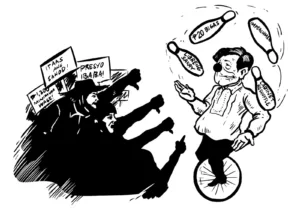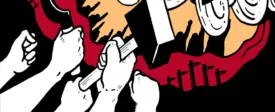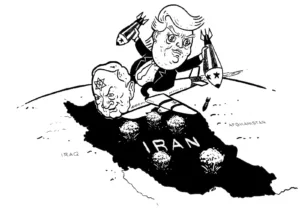Oh my god, salad!”, “And is that nilupak?” “Look, there’s pansit and even bread!” comrades exclaimed as they excitedly rummaged through the food Manoy Tano brought. “Hey, don’t give salad to those with colds, it will worsen, I’ll just take it,” joked Ka Ding, laughing. “You seem to have brought the entire birthday feast here, Manoy!”
Ka Ding’s unit is operating in Camarines Norte villages being subjected to the military’s Mobile Community Support Service Program. Two battalions are currently stationed in the province: the 85th IB and 16th IB under the 2nd ID based in Camp Capinpin in Tanay, Rizal, and the 201st IBde based in the town of Guinayangan, Quezon. These are part of the Joint Task Force in the Quezon-Bicol Zone, which the Armed Forces of the Philippines (AFP) established in a desperate attempt to end the armed movement in the border of Quezon and Camarines Norte.
The AFP declared Quezon “insurgency-free” in July 2023 and Camarines Norte in January 2023. However, an NPA ambush in Tagkawayan, Quezon later that year refuted this claim.
Despite the renewed militarization efforts in the area, the NPA unit adapted quickly. The unit overcame the constant presence of the enemy by adjusting their methods of work among the masses. The unit’s political officer Ka Anding said, “Looking at it positively, the enemy’s actions pushed us to expand our area of work and reach more masses. Who would have expected that the masses would still warmly receive us here in Baryo Ligaya?”
It had been years since any NPA unit had visited Ligaya. However, the return of Ka Anding’s unit was warmly received by old-time supporters of the people’s army. One of those who warmly welcomed them was Tay Monsur, who used to host comrades and served as a militia member.
While having lunch on their bivouac, Red fighters also chanced upon and reestablished links with Manoy Berting, who was also part of the mass base. In the informal gathering, one of the comrades recalled that Manoy Berting’s family had previously served as contacts of the people’s army. After a lengthy and substantial update and sharing, Manoy Berting invited the comrades to temporarily stay on his property.
“It’s safe there, comrades, it’s away from the military’s patrol route,” he said. The unit accepted the invitation and stayed for several days. The comrades helped in production work, assisted with coconut dehusking, and copra processing. They also launched a social investigation into the class composition of the barangay and studied the economic issues confronting the residents. The masses’ solid trust in their army became evident when they specifically sought out the unit to air their grievances regarding their land and the bad elements in the barangay.
The masses could not control their excitement to meet the Red fighters after a long absence of contact. Almost every day, they would send food, such as San Fernando (a type of taro) and bananas for snacks. The comrades were extremely grateful for the masses’ deep support for the revolution.
The unit’s experience with mass work in Baryo Ligaya was an utter repudiation to the fascist AFP’s absurd principle of “draining the water to expose the fish,” the unit declared. The water will never run dry from a living spring, no matter how hard they try.
“The oppressed and exploited masses serve as the spring that nourishes the armed revolution,” Ka Anding explained. “The unparalleled crisis of oppression, exploitation, and poverty among the Filipino people is the source of this spring. It will continue to flow for the revolution until victory.”











